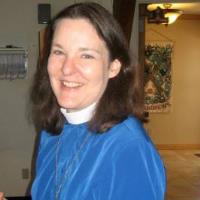Commentary on Matthew 28:1-10
Matthew’s resurrection story contrasts the life-giving power of God with death-dealing human authority.1
[Looking for commentary on John 20:1-18? See this commentary for Easter Sunday by Alicia Myers.]
Just as the crucifixion narrative echoes Jesus’ temptation in Matthew, so the resurrection highlights themes first raised at Jesus’ birth. Herod reacted to the threatening announcement that a new king had been born by trying to exterminate him, sending soldiers to kill all the babies in the region.
After the crucifixion, when the religious and civil authorities have at last succeeded in their quest to kill Jesus, they react to the threat of his resurrection by sending soldiers to seal the tomb and guard his dead body. But the God who shakes the earth cannot be stopped by armed guards and an official seal. The story that begins with fear ends with overwhelming joy. Jesus’ birth is shadowed by many deaths, but Jesus’ death brings the promise of resurrection life for all.
Matthew’s version of the resurrection story is distinctive in several ways, including the detail about the guards at the tomb and the earthquake, the conversation with a single angelic messenger (rather than with the young man described in Mark or the two angels mentioned in Luke and John), and the identity of the first people to hear the news of the resurrection. In John, Mary Magdalene comes to the tomb alone (John 20:1, 11). In Mark, she is accompanied by Mary the mother of James and by Salome (Mark 16:1). Luke agrees that Mary Magdalene and Mary the mother of James were there, but he has Joanna and the other women with them present as well (Luke 24:10).
According to Matthew, the first witnesses to God’s triumph are two of the same women who watched Jesus die. Having seen Joseph of Arimathea bury Jesus, Mary Magdalene and “the other Mary” now come again early on the first day of the week to look at the tomb (unlike the other Gospels, Matthew says nothing about their bringing spices to anoint Jesus’ body). Mary Magdalene’s identity is clear, but who is “the other Mary”?
Earlier Matthew described her as “Mary the mother of James and Joseph” (Matthew 27:56). According to Matthew 13:55, two of Jesus’ brothers are named James and Joseph. In all likelihood, then, “the other Mary” is Mary the mother of Jesus. Though the evangelist’s decision not to identify her explicitly as Jesus’ mother may seem odd, the effect is to emphasize not her biological relationship to Jesus, but her role as his disciple.
In both Mark and Luke, the women find the stone already rolled away from the tomb when they arrive. In Matthew, however, the women experience the earthquake and see the angel descend, roll away the stone, and sit on it. The guards quake with fear at the events unfolding before them. Ironically, they react to the opening of the tomb by becoming like dead people.
The angel’s first words, expressed with a present imperative in Greek, strongly contrast the guards with the women: “Don’t you be afraid,” or “As for you, stop being afraid.” The angel is commanding them to reject their current state of fear, for his news brings great joy: “I know that you are looking for Jesus the crucified one. He is not here, for he was raised just as he said.” The resurrection has already happened. The stone has been rolled away not to let Jesus out, but to let the witnesses in.
The angel sends the women to bear the news to the disciples, along with an additional message: Jesus is going ahead of them into Galilee, and they will see him there. The angel does not specify exactly which disciples they are to tell, though interestingly, he does not single out Peter (compared to Mark 16:7).
Matthew 27:57 describes Joseph of Arimathea as “discipled to Jesus,” using the verb from the same root as the Greek word for disciple, and Matthew 27:55-56 identifies the group of women who witnessed the crucifixion from a distance as “those who followed Jesus from Galilee to minister to him.” Throughout the Gospels, following Jesus means becoming a disciple. Luke says that the women told the news “to the eleven and to all the rest” (Luke 24:9), and Matthew may also have this larger group of disciples in mind.
In any case, the women immediately, “with fear and great joy” obey the angel’s command. Mark has them reacting with fear and silence, but in Matthew they run to announce the world-changing news. On the way, Jesus meets them and reiterates the angel’s command to stop being afraid. He is alive and present with them. Why should they fall prey to fear? Why should they leave room for anything except worship and overwhelming joy?
Jesus has one final command for them: “go and tell my brothers to go to Galilee; there they will see me” (Matthew 28:10). But whom does Jesus mean by “my brothers”? The final scene in Matthew shows the eleven disciples meeting with Jesus in Galilee, so at minimum Jesus is sending the women to tell the eleven. Given that one of the women is Jesus’ mother, it would be quite natural to assume that he means for her to tell James and Joseph and Simon and Judas as well (see 1 Corinthians 15:7, where Paul says that Jesus appeared to James). But are the women bearers of a message intended only for men?
It is important to point out that grammatically the Greek word translated as “brothers” could equally well be translated as “brothers and sisters.” Greek uses masculine plurals for any group that includes males, even if the group is comprised of nine women and one man. Though there are no women among the eleven, Matthew clearly includes women in the larger group of Jesus’ disciples. Furthermore, the shift in language from “disciples” to “brothers” recalls the scene in Matthew 12:46-40, where Jesus asks who his mother and brothers are and then answers his own question by saying, “Whoever does the will of my Father in heaven is my brother and sister and mother (26:50). Disciples have become family.
Mary Magdalene and Mary the mother of Jesus, commissioned by Jesus himself, become the first apostles. With great joy, they obey Jesus’ command, bearing witness to the risen Christ. The Gospel that began with a man afraid to marry his disgraced betrothed and a fearful king who tries to kill potential rivals ends with overwhelming joy. Jesus’ command to the women becomes a command to all of us: Stop being afraid! God has defeated death. Rejoice, and share the good news!
Notes
- Commentary first published on this site on April 15, 2017.


April 11, 2020